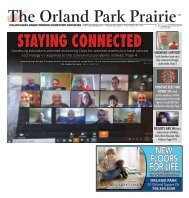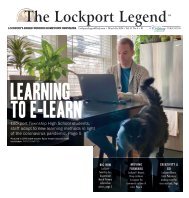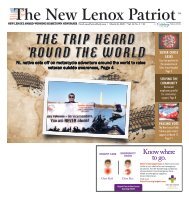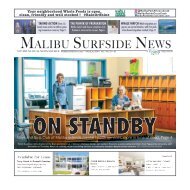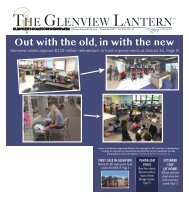MSN_032218
Malibu Surfside News 032218
Malibu Surfside News 032218
You also want an ePaper? Increase the reach of your titles
YUMPU automatically turns print PDFs into web optimized ePapers that Google loves.
14 | March 22, 2018 | Malibu surfside news News<br />
malibusurfsidenews.com<br />
Mountain lion uses culvert to cross the 101 Freeway<br />
Submitted by National Park<br />
Service<br />
National Park Service researchers<br />
have documented<br />
a rare case of a mountain<br />
lion crossing the 101 Freeway<br />
in the Liberty Canyon<br />
area of Agoura Hills, underscoring<br />
the area’s importance<br />
as the ideal location<br />
for a wildlife crossing.<br />
An adult male mountain<br />
lion known as P-64 was<br />
captured on Boeing property<br />
at the Santa Susana Field<br />
Laboratory on Feb. 28 and<br />
outfitted with a GPS collar.<br />
The following day, he<br />
headed south, and surprised<br />
researchers by crossing the<br />
101 Freeway.<br />
Trail cameras in the<br />
area show P-64, estimated<br />
to be 3 or 4 years<br />
of age, used a culvert that<br />
runs under the freeway to<br />
cross, and he is believed<br />
to be the same mountain<br />
lion that researchers have<br />
recently documented using<br />
that same culvert. His<br />
home range may include<br />
the northern portion of the<br />
Santa Monica Mountains,<br />
the Simi Hills and the Santa<br />
Susana Mountains. Adult<br />
male mountain lions can<br />
have home ranges of up to<br />
200 square miles.<br />
“It’s really interesting<br />
that this mountain lion figured<br />
out how to use this<br />
extremely long and dark<br />
culvert under the freeway,”<br />
said Seth Riley, wildlife<br />
ecologist for Santa Monica<br />
Mountains National Recreation<br />
Area. “We have had<br />
many other collared mountain<br />
lions come close to the<br />
freeway in the Liberty Canyon<br />
area and not manage to<br />
get across.”<br />
National Park Service<br />
researchers have been intensely<br />
monitoring the<br />
area for nearly three years<br />
with several trail cameras,<br />
both along Liberty Canyon<br />
Road and in nearby natural<br />
areas. During that time,<br />
cameras have detected<br />
many different species including<br />
bobcats, coyotes,<br />
mountain lions, mule deer<br />
and raccoons close to the<br />
freeway. Biologists had not<br />
confirmed that any animals<br />
managed to cross to the<br />
other side of the freeway<br />
until it was recently discovered<br />
that P-64 used the<br />
culvert to cross.<br />
From 1999-2000, CSU<br />
Northridge master’s student<br />
Sandy Ng monitored<br />
the same culvert with remote<br />
cameras and recorded<br />
zero bobcats, coyotes, deer,<br />
or mountain lions using it<br />
over a 12-month period.<br />
The culvert stretches more<br />
than 640 feet under the<br />
freeway, is sometimes full<br />
of water, and is completely<br />
dark because it bends along<br />
the way. The only animals<br />
detected during this earlier<br />
monitoring period were<br />
raccoons, skunks and an<br />
opossum.<br />
“This discovery is exciting<br />
because it reaffirms<br />
that the proposed wildlife<br />
crossing at Liberty Canyon<br />
is going in the right place<br />
and, once completed, will<br />
be used by mountain lions<br />
and other wildlife,” Riley<br />
said. “Though we clearly<br />
cannot count on the Liberty<br />
Creek culvert in general for<br />
connectivity, it shows the<br />
importance of this location<br />
and the ability and drive of<br />
these animals to find ways<br />
to get across.”<br />
Caltrans, along with<br />
numerous other partners,<br />
proposes building a wildlife<br />
crossing over the 101<br />
Freeway and Agoura Road<br />
in the Liberty Canyon area<br />
and last fall released the<br />
The adult male mountain lion known as P-64 was recently documented crossing the 101 Freeway in the Liberty<br />
Canyon area of Agoura Hills. National Park Service<br />
“This discovery is exciting because it reaffirms that<br />
the proposed wildlife crossing at Liberty Canyon is<br />
going in the right place and, once completed, will<br />
be used by mountain lions and other wildlife.”<br />
Seth Riley — wildlife ecologist for Santa Monica Mountains National Recreation<br />
Area<br />
draft initial study and environmental<br />
assessment<br />
for the project. A wide and<br />
vegetated crossing over<br />
the freeway would serve<br />
a broader range of species<br />
than a tunnel under the<br />
freeway.<br />
The 101 Freeway is a<br />
major obstacle for wildlife<br />
movement between the<br />
Santa Monica Mountains<br />
and other natural areas<br />
to the north. That lack of<br />
connectivity has led to inbreeding<br />
and reduced genetic<br />
diversity among the<br />
mountain lion population<br />
in the Santa Monica Mountains.<br />
A study co-authored<br />
in 2016 with researchers at<br />
UCLA found that without<br />
increased connectivity, especially<br />
animals moving in<br />
from the north, this would<br />
lead to the continued erosion<br />
of genetic diversity<br />
and increase the chances of<br />
extinction of the mountain<br />
range’s population.<br />
The lack of connectivity<br />
also limits dispersal of<br />
young male mountain lions,<br />
who at about 1 or 1-and-ahalf<br />
years old leave their<br />
mother to find a territory.<br />
Without the ability to easily<br />
leave the Santa Monica<br />
Mountains, young males<br />
become trapped in another<br />
male’s territory, potentially<br />
increasing the chances of<br />
conflict. While adult males<br />
generally overlap with<br />
many female lions within<br />
their territory, they will<br />
fight other males, which<br />
can lead to death.<br />
Since the mountain lion<br />
study began in 2002, P-64<br />
is only the fifth mountain<br />
lion documented to have<br />
crossed the 101 Freeway,<br />
and just the second, after<br />
P12 in 2009, to come into<br />
the Santa Monica Mountains<br />
from other natural areas<br />
to the north. During that<br />
same timeframe, 18 mountain<br />
lions have been struck<br />
and killed by vehicles on<br />
roads and freeways within<br />
the study area.<br />
The purpose of the National<br />
Park Service research<br />
is to determine how mountain<br />
lions in and around the<br />
Santa Monica Mountains<br />
survive in an increasingly<br />
fragmented and urbanized<br />
environment.<br />
The California Department<br />
of Fish and Wildlife<br />
is responsible for overseeing<br />
the management and<br />
conservation of mountain<br />
lions in the state.










